How much T3 and T4 is produced daily by your thyroid?

First, let’s clarify that T4, also commonly called thyroxine (thy-rox-een), is a thyroid storage hormone, also called a prohormone. It’s around 80% of all your produced thyroid hormones. It’s mostly meant to convert to T3, the active thyroid hormone, via the use of enzymes known as iodothyronine deiodinases. It’s the D2 deiodinase that converts T4 to T3 (as well as the D1 deiodinase) and it’s T3 that changes your life, not T4. But we always need some T3 as well.
T3, also commonly called triiodothyronine (tri-o-doh-thy-ro-neen), is the biologically active thyroid hormone, and thus, the most effective thyroid hormone. Being more biologically active means that T3 is only 20% of all produced thyroid hormones, as compared to 80% from conversion of T4 to T3. Yet, we always need some T3 in our treatment. It doesn’t work to ONLY get it from conversion.

Bound vs Unbound T4 or T3 — an additional distinction
Note that most of the T4 or T3 thyroid hormones are bound to three different blood carrier proteins (shown in labs as total T4 / TT4 or total T3 / TT3), thus mostly unusable. A very small portion are unbound from those proteins (shown in labs as free T4 and free T3), thus usable. Thus, the unbound T3 is the king’s crown. It can enter your tissues. This is why we, as patients, care a lot more about the free T3 more than the total. More about those three proteins from Google Scholar here.
Amounts per day
From the Journal titled Clinical Endocrinology with the article titled “Defending plasma T3 is a biological priority,” it is stated that “healthy adult subjects produce about 30 ug of T3/day” (ug is the same as mcg, or micrograms). It then clarifies that 25 ug/mcg of that 30 comes from the conversion of T4 to T3 (but only if all is well in your health). The remaining 5 ug/mcg is made/secreted directly from the thyroid–this why we also need T3 in our treatment to mimic what a healthy thyroid gives directly.
As far as the daily production of T4, this article states that in a day, it can be 100 ug/mcg of T4/day .
Causes of Conversion problems
Note that the above 25 ug/mcg of T3, from conversion of T4 to T3, would only happen optimally if there aren’t one of many problems we can have as thyroid patients. In other words, if we have acquired…
- chronic inflammation (attack on the thyroid; just being hypothyroid w/o Hashi’s, or other causes)
- low iron (from being on a poor treatment, which decreases iron absorption)
- high cortisol (from being poorly treated on T4-only, or underdosed on any combo and not optimal, or chronic stress
…T4 is going to convert to rising RT3, the inactive hormone, which also lowers T4, thus lowers more conversion to T3. Also, a small minority of patients can have problems with the enzyme meant to help convert T4 to T3. There are three enzymes, called iodothyronine deiodinases (D1, D2, and D3), but D2 is primarily responsible to convert T4 to T3. So if someone has a polymorphic genetic variation, D2 can have a lowered effect on conversion. See this article.
Aging has a negative effect on conversion of T4 to T3 due to a decrease in selenium levels.
Any cortisol issue (low cortisol, high cortisol, and/or low aldosterone) can cause T3 to go high in the blood and not make it to the cells, aka pooling.
Summary
T4 is a thyroid storage, prohormone. T3 is the biologically active thyroid hormone. If all things were working right, we would be making around 100mcg of T4, as well as 30mcg of T3, daily. But the reality is that most hypothyroid patients, whether from the autoimmune Hashimoto’s or other causes, are poorly treated due to a doctor’s belief in a poor training. That can mean being on nothing but T4 (which fails a strong percentage of us, sooner or later) or being underdosed even with T3 in our treatment i.e. never achieving optimal, both which can stress our adrenals and cause high cortisol issues. Thus, a percentage of us can have issues which causes the conversion of T4 to too much Reverse T3 (RT3), the inactive hormone, or pooling.
Important notes: All the information on this website is copyrighted. STTM is an information-only site based on what many patients worldwide have reported in their treatment and wisdom over the years. This is not to be taken as personal medical advice, nor to replace a relationship with your doctor. By reading this information-only website, you take full responsibility for what you choose to do with this website's information or outcomes. See the Disclaimer and Terms of Use.